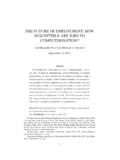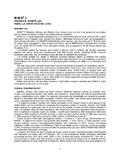Transcription of Burnout in Social Justice and Human Rights Activists ...
1 Burnout in Social Justice and Human RightsActivists: Symptoms, Causes and ImplicationsCHER WEIXIA CHEN AND PAUL C. GORSKI*AbstractAlthough people involved in every kind of professional or volunteer work can besusceptible to vocational Burnout , research suggests that Social Justice and humanrights (SJHR) Activists , whose activist work is fraught with unique challenges, can beespecially susceptible to it. Building on a small but growing body of scholarship onSJHR activist Burnout , this study is an attempt to gain insight into SJHR Activists ownexperiences. In order to deepen the relatively slim present understandings of SJHR activist Burnout , we adopted a grounded theory approach to analyse interview datafrom 22 SJHR Activists involved in a wide variety of SJHR movements and organiza-tions in the United States.
2 This analysis revealed patterns in the Activists perceptionsof the symptoms, causes, and implications of their Burnout and pointed to severaldimensions of the internal cultures of United States SJHR movements and organiza-tions, including, in the words of one our participants, a culture of martyrdom , thathasten activist Burnout and, as a result, render SJHR activism less effective and effi-cient. We discussed these findings and how they might inform efforts to strengthenSJHR movements by tending to the well-being of SJHR : Burnout ; culture of martyrdom; Social Justice and Human rightsactivismIntroductionSocial Justice and Human Rights (SJHR) Activists , whose work renders themsusceptible to emotional and physical exhaustion (Maslach and Gomes 2006),need tools to tend to their own well-being.
3 Unfortunately, most people in ourown circles of SJHR Activists in the United States are not intentional abouttending to their own well-being. Doing so is associated in some SJHR circleswith a lack of commitment or with self-indulgence (Plyler 2006). Some rightsdefenders and Activists perceive self-care as contradicting an implicit pact of selflessness asRodgers (2010)found in her study of people working withAmnesty International. The combination of the emotional toll of SJHR workand the culture of selflessness can hasten activist Burnout , a condition,described in more detail later, which often results in people scaling back on orfully disengaging from their SJHR activism (Rettig 2006).
4 *Cher Weixia Chen is an Assistant Professor in New Century Collegeand a Research Fellow in the Center for the Advancement of Well-Being, George MasonUniversity, Virginia, USA. Her scholarship centres on Human Rights . Paul C. Gorski( is an Associate Professor in New Century College and a ResearchFellow in the Center for the Advancement of Well-Being, George Mason University. His workand passion is Social Justice of Human Rights Practice Vol. 0 | Number 0 | Month 2015 | pp. 1 25 #The Author 2015. Published by Oxford University Press. All Rights reserved. by guest on September 27, 2015 from This study was conceived out of a desire to learn more about the implica-tions of these and other conditions for the physical and emotional well-beingof SJHR Activists .)
5 Much has been written about activist Burnout and the tollSJHR activism can take emotionally and physically on Activists ( Gomes 2006; Klandermans 2003). Most of this scholarship has focusedon people s experiences with Burnout in particular SJHR organizations ormovements in the United States, such as the Plowshares (Nepstad 2004) or thepeace movement (Gomes 1992). Although some researchers have speculatedon the range of symptoms of Burnout among Activists , few have attempted todocument those symptoms through the stories of the Activists the deleterious effects activist Burnout can have on Social movements on the work of Rights defenders and other Activists it was the aim of thisstudy to build upon the existing scholarship by helping to map out more pre-cisely what activist Burnout looks and feels like for people in a wide array ofSJHR contexts in the United States.
6 Doing so could be one step toward beingable to identify research-based strategies for mitigating activist Burnout andtending to the well-being of SJHR order to do so, using a grounded theory approach, we analysed data frominterviews with 22 United States-based SJHR Activists who self-identified ashaving experienced activist Burnout . Our primary research question was:How do United States-based Social Justice and Human Rights Activists charac-terize the symptoms, causes, and implications of activist Burnout ?This re-search question was framed purposefully and specifically to capture nuancesrelated to how SJHR Activists understand and describe their own experienceswith activist Burnout rather than attempting to more broadly theorize thebreadth of Burnout among all SJHR Activists .
7 As conceptualized for thisstudy,symptomsreferred to the micro-effects that Burnout had on the acti-vists how they experienced Burnout physically, emotionally, and to participants perceptions of the conditions and experiencesthat led to their Burnout . Finally,implicationsreferred to the impact of theactivists Burnout on their activism and their lives more reviewA growing body of scholarship describes the challenges associated with beingan SJHR activist. For example, in her study of the stressors and rewards USpeace Activists associate with their activism,Gomes (1992)found publicapathy, the slowness of progress, a lack of resources, and tense relationshipswithin the peace movement to be among their most common , such asDownton and Wehr (1998), who also studied the experiencesof peace Activists , andNepstad (2004), who examined activist commitment inthe Plowshares movement, focused on how Activists sustained themselvesthrough these sorts of and Wehr (1998)
8 Found, forexample, that Activists who persisted in the peace movement despite the stres-sors were likely to have created close bonds with movement leaders, learnedCher Weixia Chen and Paul C. Gorski2 by guest on September 27, 2015 from how to manage criticism, and associated success in their activism with theirpersonal growth. The ability to withstand these stressors is described by theseand other scholars as activist persistence or activist burnoutThe inverse of the activist persistence or activist sustainability as examined bythese scholars is activist Burnout . The notion of Burnout was conceptualizedinitially byFreudenberger (1974). Unlike the common use of Burnout , whichmight describe temporary bouts with work stress, Freudenberger describedsomething more debilitating and long-term.
9 Building on his conception,Maslach and Leiter (2005)clarified that Burnout is not just about having abad day or a temporary struggle with stress. It is a chronic condition. Burnoutresults in people once highly committed to a movement or cause or organiza-tion growing mentally exhausted (Schaufeli and Buunk 2002) and, as a result,losing the idealism and spirit that once drove them to work for Social change(Pines 1994). Social Justice and Human Rights Activists are especially susceptible toburnout because they put pressure on themselves to have a significant impacton the world around them (Pines 1994). SJHR activism requires an emotionalinvestment, or whatGoodwin and Pfaff (2001)described asemotionallabour.
10 The investment of emotional labour among SJHR Activists may beheightened even in comparison with that expended by people doing otherforms of activism for two reasons. First, according to Maslach and Gomes(2006: 43), activism related to Social Justice and Human Rights concernsrequires Activists to develop a deep understanding of overwhelming Social con-ditions related to suffering and oppression conditions that society as a wholeoften is unable or unwilling to face . This burden weighing on SJHR Activists consciousness increases their levels of stress and self-inflicted pressure, elevat-ing the threat of activist Burnout (Kovan and Dirkx 2003). Secondly, despitethe emotional and physical toll SJHR activism takes on SJHR Activists , studieshave shown that many SJHR organizations and activist groups dismiss the im-portance of discussing or reflecting upon activist Burnout (Pigni 2013; Plyler2006).








